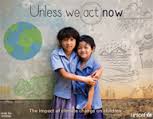Unless we act now: The impact of climate change on children

Published just ahead of COP 21 in Paris, this report provides readers with an evidence base, clear key messages, and useful maps and infographics. These examine the risks of children in relation to climate change, their current and anticipated exposure under different climate scenarios, and policy actions that are required to mitigate and adapt and, hence, protect children from adverse impacts.
Children form a group that is particularly vulnerable and expected to suffer disproportionally – physically and psychologically, directly and indirectly – from the dangers of a changing climate. They are heavily affected by existing inequalities, both in their levels of exposure to climate change impacts as well as in their capacity to cope and adapt. And they have to deal with multiple and cumulative crises, while being heavily dependent on their families and caretakers.
The first section of the UNICEF report examines the alarming figures for exposure and potential risks and impacts of climate change on children. The section is structured according to particular hazards (e.g. floods and severe storms and lethal and debilitating diseases) under some climate and population development scenarios. The report states how many children are estimated to be affected and how they are geographically distributed; their potential effects, especially on low-income families; the particular vulnerabilities of children; and their multiple disadvantages and overlapping crises.
The second section then thinks through the potential climate action scenarios, as well as how business-as-usual pathways and more ambitious and decisive climate change mitigation and adaptation might impact children now and in the future. Keeping in mind the uncertainties and probabilities of different scenarios for 2050, the authors highlight in relation to the level of exposure that “under a business-as-usual scenario, by 2050 1.45 billion children are projected to live in zones where the maximum average surface temperature will change by greater than 2°C. Under a moderately ambitious action scenario, this number is projected to drop to around 750 million children. Under a highly ambitious action scenario, the number would drop to 150 million children” (page 58).
The last part section briefly outlines a climate agenda for children, which might be interesting for readers to compare and contrast retrospectively with the outcomes of the COP. It includes imperatives to cut emissions so that global temperature increases are limited to ideally 1.5°C, reduce inequity among children and promote their future resilience to climate change and environmental risks, listen and act on their perspective, scale up proven approaches (such as vaccination programmes), and invest in children when implementing national climate change plans.
The authors frequently embed the report into a larger context by highlighting that challenges for children are severe even without climate change. Urgent yet long-term action is needed, because children will live longer than most of the reports’ readers, and children already pay and will continue to pay the price for adults’ past and current (in)actions. “Protecting the planet and protecting our children go hand- in-hand – and both can be achieved if we all act now” (page 68).
Available from: http://www.unicef.org/publications/index_86337.html
Book note prepared by Julia Wesely
Search the Book notes database
Our Book notes database contains details and summaries of all the publications included in Book notes since 1993 - with details on how to obtain/download.
Use the search form above, or visit the Book notes landing page for more options and latest content.
For a searchable database for papers in Environment and Urbanization, go to http://eau.sagepub.com/

